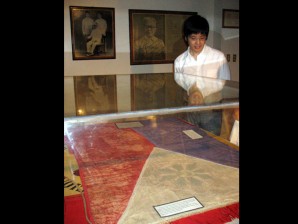Filipinos described as risk-takers at ‘banig’ flag rites

“We have a heritage of heroic risk-takers who did this risk-taking on behalf of what we now call human rights,” said author Felice Santa Maria during a recent gathering of Ayala Land officials and residents at Ayala Triangle Gardens.
Unveiled during the event was a 50-sq-m Philippine flag made of banig (traditional woven mat).
Santa Maria noted that Filipinos took risks in their struggles for democracy—first in 1896 against colonial rule and again 90 years later during the popular revolt against the Marcos dictatorship.
The author drew parallels between uprisings against the Spaniards and the dictatorship, saying that Filipinos had consistently taken risks to gain their freedom.
She recalled the struggle of both Filipino intellectuals and revolutionaries who sacrificed life and limb to attain “taxation with representation” and self-governance, among other things.
Article continues after this advertisementThe trait of risk-taking continued until the tail-end of martial law, she said, when the Marcos dictatorship began losing its grip on power.
Article continues after this advertisementWhen Makati became a center for the “yellow confetti revolution,” she said business owners in the country’s financial capital knew the stakes were high and yet took a gamble with their fortunes to restore democracy.
“Those were the days when people who owned companies, people who were leaders in media and education were hauled off, threatened and incarcerated. Many people who owned businesses lost control of them,” Santa Maria said.
The giant Filipino flag is the third of its kind, according to Carmela Ignacio, assistant vice president at Ayala Land. She said the company had been mounting displays of the national colors at Ayala Triangle Gardens since 2009.
The first display was a floral flag while the second was a 3D installation.
This time, Ignacio said, the company wanted to highlight the banig, a sturdy material which Filipinos use to sleep on. The banig flag was made out of tikog grass and woven for a month by artisans from Basey, Samar.